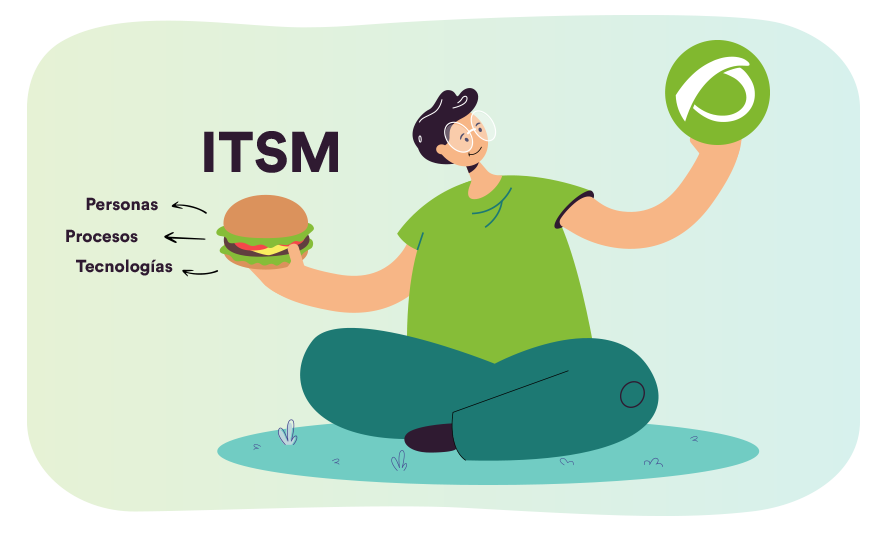“In this bleak world where technology has become a vital necessity, IT Service Management (ITSM) has become a key tool for many businesses.” It sounds like the introduction to a dystopian novel, doesn’t it? Easy, it’s not like that, today I didn’t get up very like Aldous Huxley.
We will rather answer the question: What is ITSM exactly?
Don’t you worry, I will not get too involved with the technicalities, you already know what we’re like, I will explain it to you in an easy way and worth prizes such as the Nobel Prize for scientific dissemination.
Advantages of ITSM: Improve IT service management
What exactly is ITSM?
*Warning: Allegory for children.
Imagine that ITSM is the detective of a company. It’s the tough guy who helps the organization understand how technology works in the business and how it can become more efficient. But to be a good detective, ITSM needs three elements: people, processes, and technology.
People are important in ITSM because they are the ones who use the company’s IT services. End users, employees, customers, and external vendors are all people who need the company’s IT services to do their jobs.
The implementation of ITSM helps define the roles and responsibilities of each user group, and ensures that everyone understands how they can contribute to improving the management of IT services.
Processes are also important in ITSM. And we’ll go crazy inserting an analogy into another analogy. Inception!
If ITSM were a hamburger, the processes would be like hamburger mince.
Processes are the different stages that the company’s IT services go through, such as incident management, IT asset management, and change management. A good ITSM implementation will help the company define these processes and ensure that they are followed correctly.
If we continue with the hamburger simile, technology is like ITSM’s hamburger cheese. It is the ingredient that holds everything together with its caloric value.
Technology allows the company to automate its processes and improve access to service providers and end users. Automation reduces errors, brings consistency and service metrics based on critical success factors.
Although if you got lost in the middle of my great allegory of detectives and hamburgers I leave you here a more academic and cheeseless definition:
ITSM is the acronym for Information Technology Service Management, which refers to a set of practices, policies, procedures and tools used to plan, design, deliver, operate and control the information technology (IT) services that a company offers to its internal or external customers.
ITSM is based on the service management approach and focuses on customer satisfaction, continuous improvement of services and efficient management of IT costs and resources.
ITSM includes processes and areas such as incident management, problem management, change management, asset and configuration management, service level management, and capacity management.
Implementing ITSM enables companies to improve the quality of their IT services, increase the efficiency and effectiveness of their processes, and reduce the risks and costs associated with information technology management.
Now that we know what ITSM is, what are the keys to its implementation?
Well, there are some key requirements that need to be met.
- First, the roles and responsibilities of end-users must be defined.
- Secondly, the processes to be followed must be defined, such as incident management, IT asset management and change management.
- And finally, the right technology must be implemented to automate these processes and improve access to IT services.
When implementing new ITSM processes, the key is to adapt to the specific needs of your business.
If your IT support team is always working on the same problems, finding the root cause and solving it is undoubtedly the best option.
For example, if storage space is a recurring problem, deleting files every time the hard drive reaches its maximum capacity is not a long-term solution.
Instead, installing a hard drive with greater capacity would be a more effective solution over time.
In ITSM, the incident management process becomes problem management.
In this example, the lack of storage space is the incidence, while the storage capacity of the hard drive is the underlying problem.
But the implementation of ITSM processes depends not only on the tool used, but also on a culture change.
It’s important for end users to see the IT team as a service provider, rather than just another department of the company.
Key points to consider when implementing ITSM processes are team maturity and size, identifying specific issues, and selecting the right framework.
Each framework has its own structure and processes, so the choice will depend largely on the problems to be solved.
Once ITSM has been implemented, what are the advantages and why is it important?
There are many benefits to implementing ITSM.
ITSM processes are key for companies looking to optimize the management of their IT services and improve customer satisfaction.
Clearly defining service delivery goals, publishing an IT Service Catalog, and creating well-trained and enthusiastic support teams are just a few of the ways ITSM can benefit a company.
In addition, a good ITSM implementation can ensure quick troubleshooting, saving end users time and reducing help desk workload.
This, in turn, can reduce IT service provision costs and increase service availability and trust.
Last but not least, ITSM ensures compatibility with different regulations or legal regulations, which is crucial for companies looking to comply with security and privacy standards.
In short, implementing ITSM processes can provide a number of benefits to businesses, from better management of IT services to greater customer satisfaction and greater compliance with legal regulations.
But what about ITIL?
ITIL is a very popular ITSM framework, but it’s not the only option.
There are other frameworks and standards, such as COBIT, ISO 20000, MOF and USMBOK, that can also be used to manage IT services.
The main difference between ITIL and other frameworks is that ITIL is very prescriptive and specific about how IT services should be managed, while other frameworks are more flexible and allow companies to customize their processes according to their specific needs.
Despite the differences between ITSM and ITIL, both are important for IT service management.
ITIL is a good choice for companies looking for a more detailed and structured solution, while other frameworks may be better suited for companies that need a more flexible and customized solution.
Conclusions
What else can we say, the implementation of ITSM is fundamental for the efficient management of IT services in companies.
Like a seasoned detective, ITSM helps the organization understand how technology works in the business and how it can be more efficient.
With the right definition of roles and responsibilities, well-defined processes, and implementation of the right technology, ITSM can improve the quality of IT services and increase end-user satisfaction.
Whether using ITIL or any other framework, ITSM is a key tool for any company that wants to stay competitive in the increasingly technological world in which we live.
And remember, if you ever have problems with your company’s IT services, don’t worry, because ITSM is here to help you solve the mystery and make everything run smoothly!
As the famous detective Sherlock Holmes once said, “when the impossible has been removed, what remains, however improbable it may seem, is the truth”. And the truth is that ITSM is a powerful tool to improve the management of IT services in your company.

Dimas P.L., de la lejana y exótica Vega Baja, CasiMurcia, periodista, redactor, taumaturgo del contenido y campeón de espantar palomas en los parques. Actualmente resido en Madrid donde trabajo como paladín de la comunicación en Pandora FMS y periodista freelance cultural en cualquier medio que se ofrezca. También me vuelvo loco escribiendo y recitando por los círculos poéticos más profundos y oscuros de la ciudad.
Dimas P.L., from the distant and exotic Vega Baja, CasiMurcia, journalist, editor, thaumaturgist of content and champion of scaring pigeons in parks. I currently live in Madrid where I work as a communication champion in Pandora FMS and as a freelance cultural journalist in any media offered. I also go crazy writing and reciting in the deepest and darkest poetic circles of the city.
















